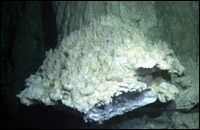"... how little we know"
It would be another day before Kelley and Karson could arrange to take Alvin to the vent area to learn more. At a science meeting held the day in between, Monday, Dec. 4, investigators summed up the evidence that had been gathered so far. "This is a fundamental discovery, no two ways about it," said Blackman, the expedition's chief scientist.
"Discovering these things is another example of how little we know about the ocean," Cann mused later that day while reviewing videos Argo made the previous night.

Fig. 6. Retrieving Alvin in rough seas.
Kelley's and Karson's Tuesday, Dec. 5 Alvin dive to the vents had to be ended several hours early after the power-intensive work drained the sub's batteries. The weather was also unexpectedly deteriorating. By 1:45 p.m., when Alvin reached the surface, winds were stirring up large enough swells and frothing whitecaps to make the submarine and the motor launch Avon lurch and toss about like amusement park rides.
Wave-washed swimmer Phillip Forte, who is also an Alvin pilot, had to grasp Alvin's sail firmly as he communicated with the cockpit via telephone. And raising Alvin from pitching ocean to pitching deck required precise timing by A-Frame operator Charles Lewis - also Atlantis' communications and electronics technician - to avoid a collision.
It took a while for Alvin to stop swinging in the A-Frame. After the access ladder was finally linked to the hull, Karson and Kelley climbed down brimming with excitement. "Fantastic," Karson said of the stone chimneys. "Their size is just incredible," added Kelley.
Kelley said the large edifices grow by the continuous fracturing of their own outer walls. That allows fluids to flow out and precipitate on the structures' outer surfaces, increasing their widths. The structures also grow at the top by the same kind of mineral deposition.
At this site, fluid venting from the chimneys' sides creates unusual growths, called "flanges," bowl-shaped mineral facsimiles of the parasitic growths sometimes found on trees. Jutting outward several meters from the structures' walls, the flanges trap heated fluids that, because of density contrasts with the cold surrounding seawater, have a mirror-like appearance.

Fig. 7. This image shows a carbonate ledge or flange that extends outwardly from the trunk of a 160 foot chimney in the Lost City hydrothermal vent field. The flanges trap pools of 160 degree Fahrenheit fluids. The nutrient-rich fluids support dense microbial communities. Photo courtesy National Science Foundation news release, http://www.nsf.gov/od/lpa/news/press/00/pr0093.htm.
These warm pools support dense colonies of microbes that live off the dissolved gases in the vent fluids, Kelley added. Similar, but not identical, flanges found at the Endeavour vent fields have been found to contain dense microbial colonies.
Besides mirror-like pools, the pair often saw shimmering water emanating from a number of cracks in rock faces, as well as from the sides and tops of the spires. Alvin expedition leader Patrick Hickey, serving as pilot, measured water temperatures as high as 71 degrees centigrade (160 F). That's hot enough to scald, though not near as hot as at Endeavor's smokers.
Setting the minisub down in tight places between formations, Hickey also used the craft's mechanical arms to snare a number of samples of the scalloped beige and white materials the edifices are made of.
Today's pages:
"When I first saw them ..." | The towers | "... how little we know" | Life between a rock and a hot place | Plans for the lab back home

| 
|
|


